|
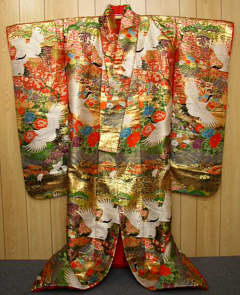
So what does the bride wear?
Lots of stuff...
The Bride wears a number of different layers of Kimono
and sash. Starting from the first to the last...
Shoes
& Socks
Don't
forget your feet! You will likely wear zori or geta sandals
along with tabi socks, which are split-toed socks. There are
a number of styles of both zori and geta. See below for
examples.

Tabi Socks |
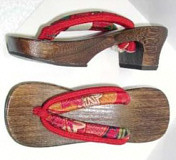
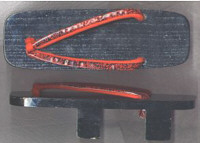
Geta Sandals |
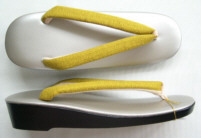
Zori Sandals |
Hada
Juban
It's time for the undies now that you've said goodbye to your feet. The first layer is the hada juban. Hada means skin.
Hada juban is underwear (or undershirt) that is worn as the first under undergarment.
Hada juban is washable and prevents the Naga juban and Kimono from getting dirty.
It comes in both one piece and two piece.
Naga Juban
More underwear! This
is an undergarment (full-length) worn over the Hada juban, and under
the kimono. They're usually 'prettier' than the hada juban.
I know, you're saying 'but who will see it?'. Well
it's the same principle as buying western underwear. Who's
gonna see your little hearts or flowers? They come in all kinds of colors and in two piece and one
piece.
|
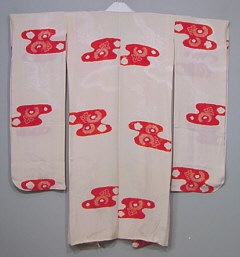
Naga Juban with long sleeves for a 'furisode' kimono
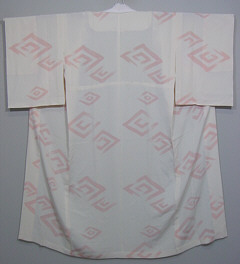
Naga Juban with short sleeves for a kimono
|

Naga Juban two piece with shorter sleeves
|
|
|
Koshi
Himo
The belting
begins. If you didn't already need to use one to tie your
Hada juban underwear on, you'll probably need one for the
naga juban. You can get them in packs, usually two or three.
They come in silk and in basic white muslin at least.
|

silk
|
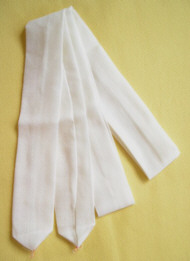
muslin
|
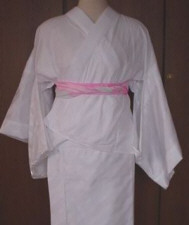
Example
of how to wear the koshi himo over a two piece juban
|
Date Jime
What?
Another belt you say? Why yes. It's the date jime and like
the koshi himo this is not the only time you will see it. Date-jime is the second belt to tie around the waist over Koshi Himo first belt (before Obi belt) to hold Nagajuban and Kimono in place.
Date jime also makes a foundation for Obi belt. Silk Hakata Ori brocade is the best fabric for
Date jime.
|
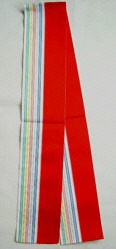
The
date jime
|
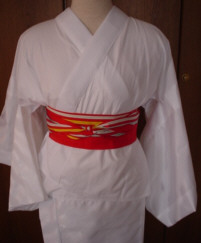
Example
of how to wear the date jime over a koshi himo which
is over a juban
|

Example
of how to wear the date jime over a koshi himo which
is over a kimono!
|
Kimono
- Kakeshita
Finally...
The kimono. In this case - for the bride - it is called a
kakeshita. It has nice loooong sleeves. Some times it will
have a slight padding along the bottom. Kimonos and
furisodes (the long sleeved kimono which is the same type as
the kakeshita) come in a billion different colors, styles,
fabrics. Here are a few examples of furisode kimono. Brides
will often wear red and white which symbolize joy. The long
sleeves indicate that the person wearing the kimono is a
young single gal. :) When she is married she starts to wear
shorter sleeves. Is that like having your wings clipped?
Hummmm...
The
Obi
So many to
choose from... Fukuro obi, maru obi, nagoya obi, han haba
obi... but if you're the bride you'll be wanting to wear
either maru or fukuro obi. They are usually 12 inches wide
all the length. They are 13 feet long plus in most cases.
Maru-Obi is ranked the
highest in all the formal Obi. It originally has twice the
width compared with that of others, and then doubles to be
completed for putting on. So this is quite a gorgeous obi
which has single pattern spread throughout both the front
and the reverse side. Around the 40's or 50's, Maru-Obi was
developed into Fukuro-Obi making itself easier to put on. So
Fukuro- Obi still has ceremonial or formal aspects, but
comes to be put on rather casual occasions, too, carrying
the pattern on the front side only. Nagoya-Obi is used in
the wide range of occasions from the casual to the formal,
which was invented in the Taisho Period. You can distinguish
Nagoya-Obi from others because of the difference of their
shapes. Nagoya-Obi has a narrow part and a wider part.
"Hanhaba" means "half the width".
Hanhaba-Obi is usually put on with casual kimono so that you
can do little things. The main feature is "easy to put
on, easy to take off". The reversible ones are often
seen with gorgeous embroidery.
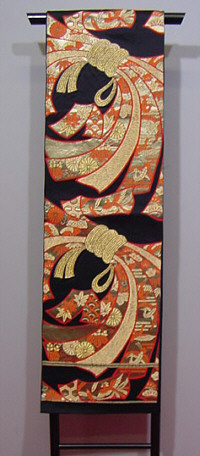
Fukuro obi |
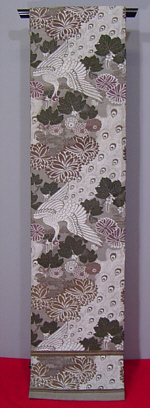
Maru Obi
|
Obi
Ita
The flat obi ita or obi stay is inserted between the
obi and the kimono to prevent the obi and kimono from
becoming wrinkled from bending and other things you
won't be doing much of while you have all of these belts
on.
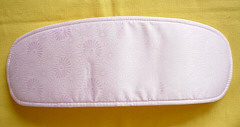
Makura
Pillow
The obi makura or obi pad is used to shape the bow
into which the obi is tied when worn with a kimono. This
one is inside of a sheer sleeve which can be used as a
belt to hold it in place.

Obi
Age
The obi age (bustle sash) is used to cover the obi
makura (obi pad) and to hold the obi crest line in
place. The sash will usually match the obi jime. See the
image to the left which is a set of obi age and obi
jime.
Obi Jiime
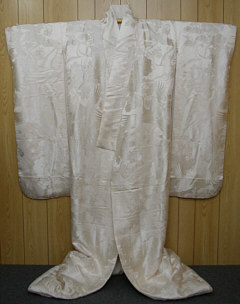 Uchikake
/ Shiromuku Uchikake
/ Shiromuku
A
Shiromuku type kimono (shiro meaning white) is a symbol of
the bride being ready for the groom's family to paint on
her blank canvas. Bleh. Another tradition I have heard of
is that the white tells the bride's family that she is
dead to them. She now belongs to the husband's family!
Red and white are symbols of joy
so wearing a good 'tart red' is not above board for a
bride. See some more examples and a longer description of Uchikake
on the kimono page.
| 
